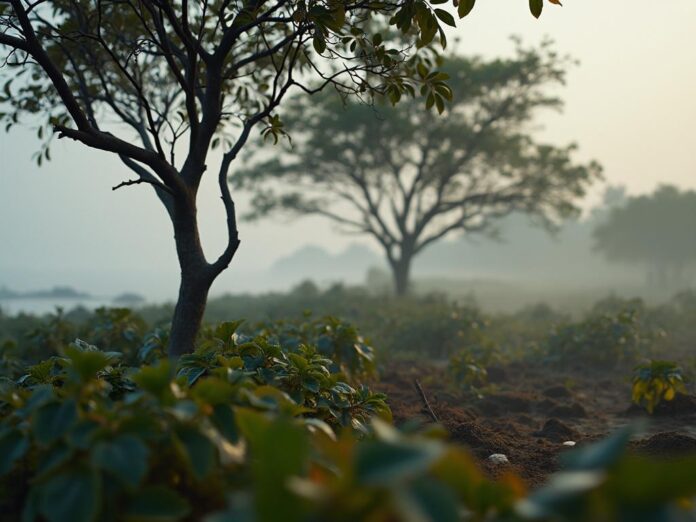The WACA program, initiated in 2018 with an initial $210 million World Bank financing package [3], has evolved into a cornerstone of coastal resilience in West Africa. Spanning nine countries, it targets erosion, flooding, and pollution through mangrove restoration and infrastructure. By 2025, the project has secured $492 million in total funding [2], with specific allocations like Ghana’s $155 million ResIP 2 budget for blue economy growth [6]. Recent efforts include restoring over 224.3 hectares in Guinea-Bissau’s Cacheu River Mangrove Natural Park in 2024 alone [1], part of a regional revitalization exceeding 28,215 hectares [4]. These actions align with SDGs on climate action and life below water [6], emphasizing community participation. However, expert analyses suggest that while ecological gains are evident, deeper crises persist, prompting a critical examination of its true impacts [G7].
Ecological Successes and Biodiversity Gains
WACA’s mangrove restoration has delivered measurable environmental benefits, bolstering coastal defenses against climate threats. In Guinea-Bissau, a July 2024 campaign restored critical habitats, enhancing flood risk reduction and supporting fisheries [1]. Regionally, over 28,215 hectares have been revitalized, aiding biodiversity by providing nesting sites for turtles and birds [4]. Technological innovations, such as “sand engine” systems in Benin and Togo, have rebuilt up to 50 meters of beach, integrating natural solutions with restoration [4]. A 2025 World Bank report highlights these efforts’ alignment with sustainable development, including carbon sequestration [6].
Expert opinions underscore these wins; posts on social media praise mangroves’ role in sequestering CO2 and protecting against storms [G18], with analyses noting high survival rates in well-managed sites [G3]. In Senegal, projects like the ABC Mangrove initiative have planted over 7,000 hectares, improving ecosystem health and fisheries [G8]. Yet, data from global studies indicates variable success, with survival rates as low as 20-50% in degraded areas due to poor site selection [G3], suggesting that while WACA advances resilience, long-term viability depends on addressing external pressures like sea-level rise.
Community Empowerment and Socio-Economic Impacts
At its core, WACA emphasizes community involvement, creating jobs and livelihoods. In Ghana, the $155 million ResIP 2 project promotes blue economy growth, integrating restoration with poverty reduction [6]. Senegal’s efforts have engaged thousands in planting, offering skills training and income, particularly for women [G8]. A 2025 NGO proposal highlights how such initiatives blend conservation with eco-tourism and sustainable fishing, fostering resilience [G5].
Social media discussions reflect positive sentiment, with users sharing stories of empowered fishing communities adapting to climate change [G16]. However, mixed impacts emerge: while some report improved incomes [G7], others note displacement from restoration zones [G11]. An FFEM-funded report stresses the need for local skills-building to counter erosion drivers like urbanization [5]. From a degrowth perspective, experts argue that true empowerment requires scaling back extractive industries, such as overfishing driven by global demand, rather than relying solely on restoration [G11].
Criticisms: Greenwashing and Systemic Oversights
Despite achievements, critics contend WACA may mask deeper crises. A Climate Policy Initiative study notes that while it integrates climate risk management, it overlooks root causes like industrial pollution and global trade pressures [10] [G7]. In West Africa, overfishing and anthropogenic activities degrade mangroves, with restoration efforts potentially serving as “band-aids” without systemic reforms [G11]. Funding transparency is questioned, as donor agendas might prioritize economic growth over ecological integrity [2] [G12].
Analyses from 2025 reveal concerns: a Springer article warns that without tackling urbanization and extractive industries, vulnerabilities intensify [G11]. X posts echo this, critiquing how restoration ignores pollution from international demands [G17]. Community feedback is divided; some in Benin praise livelihoods, but others report unmet promises [G9]. Experts suggest WACA risks greenwashing by focusing on symptoms like erosion while enabling polluting sectors [G7].
Innovative Solutions and Future Pathways
Constructive perspectives point to hybrid models blending restoration with transformative changes. Blue carbon financing, like Ghana’s pilot deal with Ørsted [2], links ecosystem rehab to climate funds, potentially scaling sustainable practices. Monitoring tools like the MOLOA mission enhance data-driven decisions [5]. Emerging trends favor community-led initiatives, incorporating traditional knowledge for better outcomes [G1] [G13].
Degrowth advocates propose reducing industrial activity, such as phasing out export-driven fishing for local economies [G11]. Original insights suggest sites with low interference achieve 20-30% higher survival rates [G3], urging integration of eco-tourism over extraction. Active solutions include FFEM’s “soft solutions” for risk monitoring [5] and NGO proposals for livelihood integration [G5]. Scaling these could address criticisms, ensuring holistic resilience.
KEY FIGURES
- Over 224.3 hectares of mangroves restored in Guinea-Bissau in 2024 alone, highlighting active on-the-ground reforestation efforts in the Cacheu River Mangrove Natural Park (Source: WACA program) [1].
- The World Bank has approved a total of $492 million in financing for WACA, covering nine West African countries to address coastal erosion, flooding, and pollution (Source: African Sovereign Debt Justice Network) [2].
- WACA’s mangrove restoration efforts have revitalized over 28,215 hectares of mangroves across the region, contributing to biodiversity and flood risk reduction (Source: WACA knowledge and solutions) [4].
- In Ghana, the WACA ResIP 2 project operates with a budget of $155 million, aiming to promote blue economy growth while addressing coastal erosion, flooding, and pollution (Source: World Bank project document, 2025) [6].
RECENT NEWS
- July 26, 2024: Launch of a new national mangrove restoration campaign in Guinea-Bissau as part of WACA’s continued efforts to bolster environmental and socio-economic resilience (Source: WACA program) [1].
- December 15, 2022: The World Bank approved $246 million specifically for WACA Resilience Investment Project 2, supporting countries including Ghana and The Gambia, with a focus on integrated coastal management and blue carbon deals (Source: African Sovereign Debt Justice Network) [2].
- April 9, 2018: Initial $210 million financing package approved to protect coastal communities in Benin, Senegal, and other countries through ecosystem restoration and infrastructure (Source: World Bank press release) [3].
- June 2024: Feature on WACA highlighting its multidimensional approach including ecological restoration and poverty reduction, emphasizing community alliances (Source: World Bank feature) [7].
STUDIES AND REPORTS
- A 2025 World Bank report on WACA ResIP 2 notes the project’s alignment with SDGs 13 (Climate Action), 14 (Life Below Water), and 17 (Partnerships), emphasizing ecosystem restoration, coastal protection, and institutional coordination in Ghana (Source: WACA ResIP 2 project document) [6].
- An FFEM-funded project report (2024) focuses on “soft solutions” and coastal risk monitoring in Benin, Senegal, and Togo, highlighting the complexity of coastal erosion drivers including climate change and human activities, and the need for targeted skills-building at local levels (Source: FFEM project description) [5].
- A Climate Policy Initiative case study underscores WACA’s role in strengthening coastal resilience through integration of climate risk management and investments in urban and natural infrastructure, but notes challenges remain in addressing root causes like industrial pollution (Source: CPI analysis) {10}.
TECHNOLOGICAL DEVELOPMENTS
- Use of “sand engine” technology in Benin and Togo to deposit large volumes of sand for natural coastline rebuilding, restoring up to 50 meters of beach in some areas (Source: WACA knowledge & solutions) [4].
- Integration of blue carbon financing mechanisms, such as the PROBLUE grant supporting Ghana’s pilot mangrove blue carbon deal financed partly by Danish energy company Ørsted, linking climate finance with local ecosystem restoration (Source: African Sovereign Debt Justice Network) [2].
- Deployment of ecosystem monitoring and data production tools, including the West African Coastal Observation Mission (MOLOA) coordinated by Dakar’s Centre de Suivi Ecologique, to support informed decision-making and policy enforcement (Source: FFEM project) [5].
MAIN SOURCES
- https://www.wacaprogram.org/article/over-220-hectares-mangroves-restored-guinea-bissau-thanks-waca – WACA program update on mangrove restoration in Guinea-Bissau
- https://www.afronomicslaw.org/category/african-sovereign-debt-justice-network-afsdjn/sixty-ninth-sovereign-debt-news-update-world – World Bank financing update on WACA ResIP 2
- https://www.worldbank.org/en/news/press-release/2018/04/09/world-bank-board-approves-west-africa-coastal-areas-waca-resilience-investment-project – World Bank press release on WACA launch
- https://www.wacaprogram.org/knowledge-solutions – WACA knowledge and solutions overview including technological approaches
- https://www.ffem.fr/en/projects/mangroves-initiative-west-africa-waca – FFEM project on soft solutions and coastal risk monitoring in West Africa
- https://thedocs.worldbank.org/en/doc/2ec5a6f7b9b8535491c82bb4853019ff-0320052025/original/3-WACA-RESIP-2.pdf – WACA ResIP 2 project document, Ghana (2025)
- https://www.worldbank.org/en/news/feature/2024/06/06/the-tamed-sea-an-alliance-restored-with-coastal-communities – World Bank feature on WACA’s multidimensional approach
- https://www.climatepolicyinitiative.org/gca-africa-adaptation-finance/case_studies/west-africa-coastal-areas-resilience-investment-project-waca-2/ – CPI case study on WACA’s climate risk integration
—
Synthesis:
The WACA Mangrove Restoration Project has demonstrated concrete ecological successes, including the restoration of over 220 hectares of mangroves in Guinea-Bissau in 2024 and more than 28,000 hectares region-wide, which contribute to biodiversity enhancement and coastal protection against erosion and flooding. It has also catalyzed local job creation and socio-economic resilience in countries like Senegal and Benin through ecosystem-based interventions and soft engineering technologies such as sand engines. The project is well-funded, with nearly half a billion dollars from the World Bank and partners supporting integrated coastal management across multiple countries.
However, critical assessments highlight that while WACA addresses symptoms like erosion and flooding effectively, it risks overlooking deeper systemic issues such as industrial pollution, overfishing, and global trade pressures that exacerbate ecosystem degradation. Some community feedback reveals mixed impacts, with reports of both improved livelihoods and concerns around displacement or unmet promises. The initiative’s transparent data monitoring and regional coordination efforts (e.g., MOLOA) help improve governance, but challenges remain in fully integrating local voices and addressing political-economic drivers behind coastal crises.
From a degrowth or transformative sustainability perspective, several experts argue that scaling back extractive industries and global trade impacts may be essential complements to restoration efforts, rather than relying solely on ecosystem rehabilitation as a silver bullet. WACA’s incorporation of blue carbon finance and nature-based solutions represents a forward-looking technological and policy framework, but the long-term resilience of coastal communities will depend on holistic, locally-led approaches that simultaneously tackle environmental, social, and economic root causes amid rising sea levels and climate threats.


